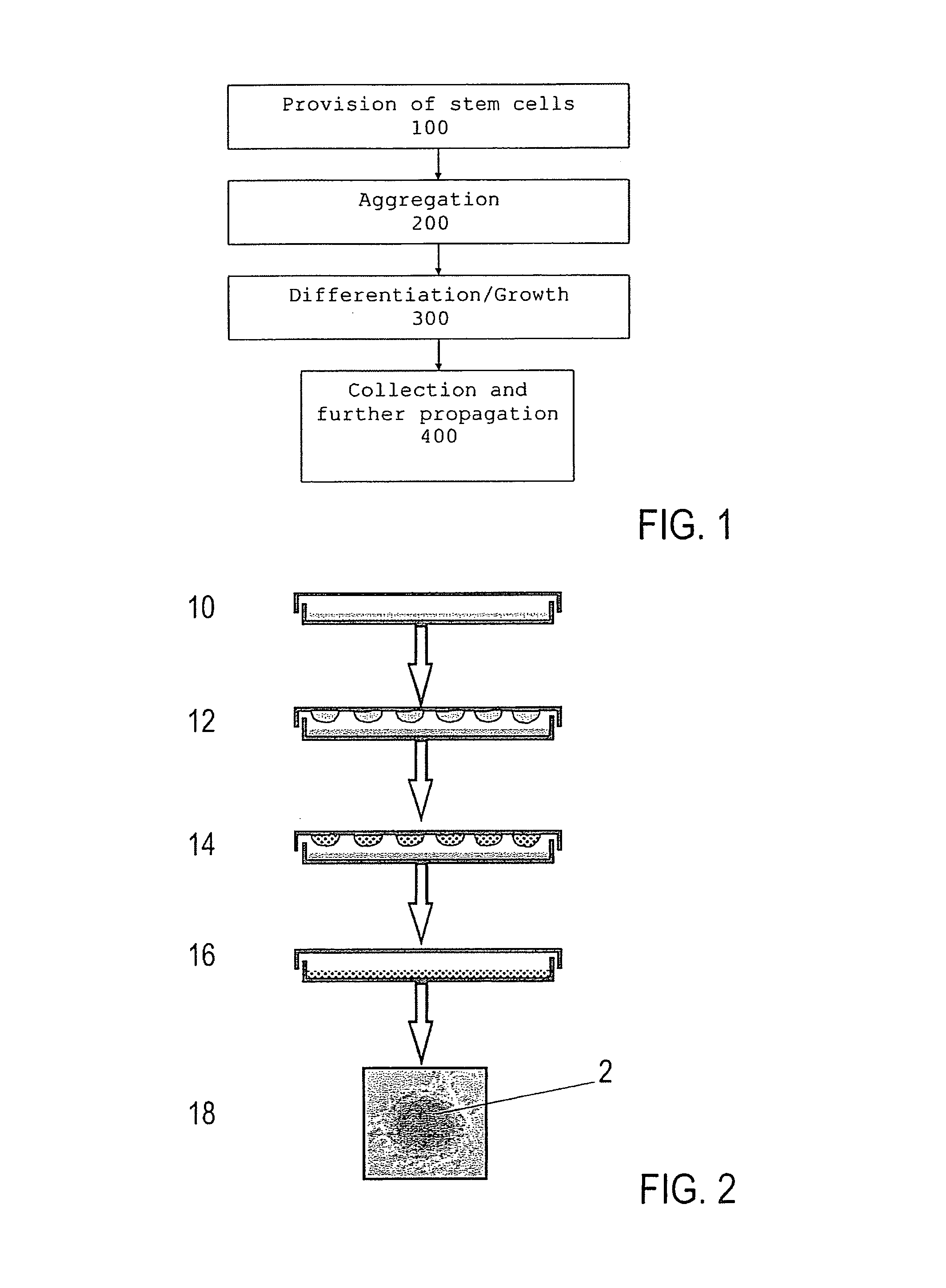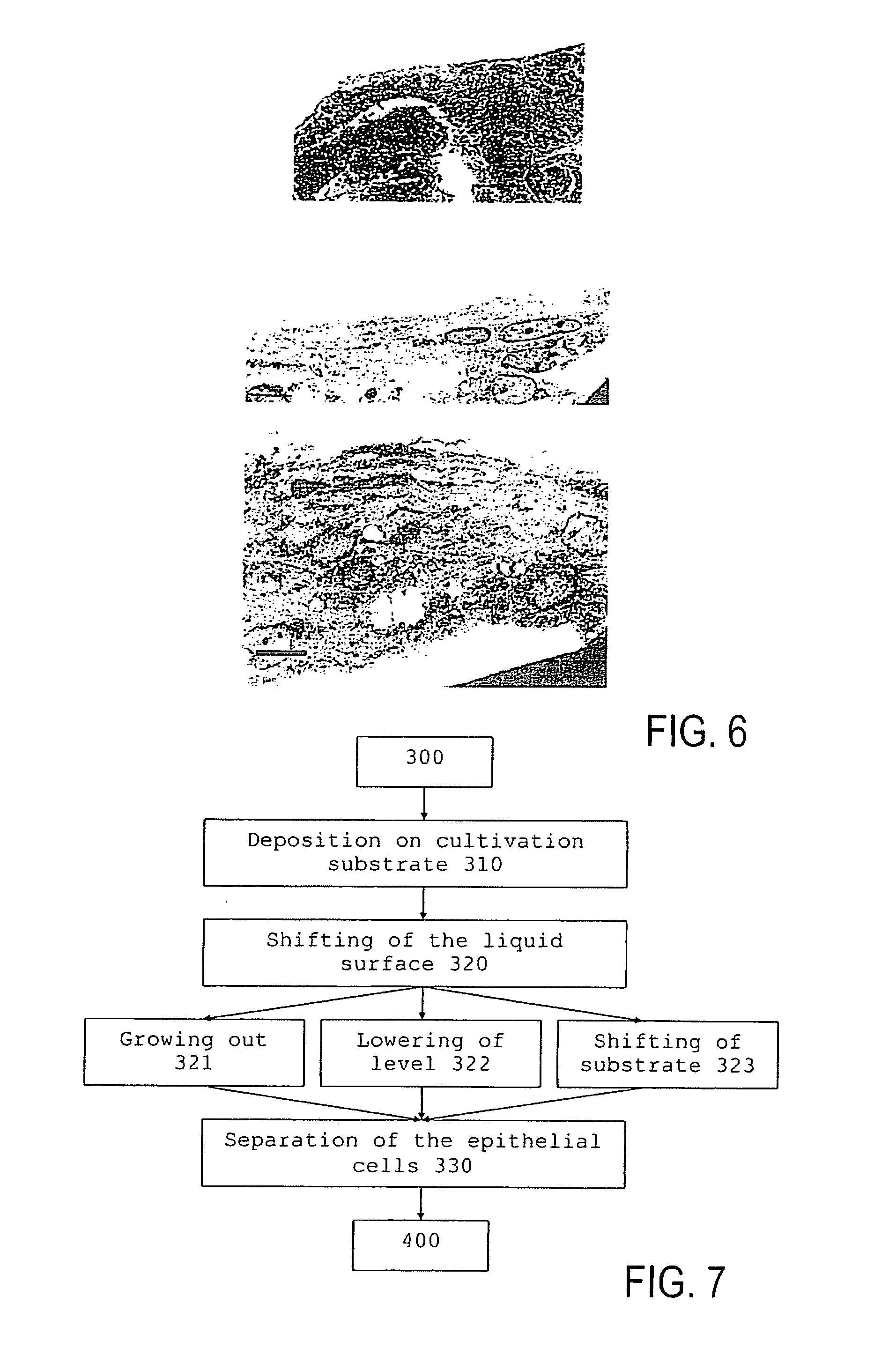Method for the production of a cell composition containing epithelial cells
a cell composition and epithelial cell technology, applied in the field of epithelial cell production processes, can solve the problems of ethical limitations in the generation of epithelial cells from embryonic stem cells, and achieve the effects of improving cellular compositions, and reducing the risk of infection
- Summary
- Abstract
- Description
- Claims
- Application Information
AI Technical Summary
Benefits of technology
Problems solved by technology
Method used
Image
Examples
example 1
1. Preparation of the Tissue and Isolation of the Cells
[0054]Using a syringe and a blunt cannula, 10 mL digestion medium was injected slowly and without bubbles into the pancreatic duct of two- to three-year-old rats. The entire pancreas is inflated by this procedure and thus, can be removed and prepared more easily. The pancreas is then transferred to a glass beaker and another 5 mL digestion medium is added. After removing the fatty tissue and lymph nodes, the tissue is divided very finely in the glass beaker using fine scissors, fatty tissue floating at the top is removed by suction and the suspension is then gassed with carbogen for one minute (repeating if necessary) and incubated for 20 minutes at 37° C., covered with aluminum foil, in an agitator at 200 cycles per minute. Then the medium is cautiously removed with suction, the tissue is divided again using scissors and the tissue fragments are washed twice each with 10 mL isolation medium and then 5 mL digestion medium is aga...
example 2
[0060]Pancreatic acini were obtained from male Sprague-Dawley rats (20 to 300 g) which had been anesthetized (CO2) and exsanguinated through the dorsal aorta. A cannula was introduced transduodenally into the pancreatic duct and 10 mL digestion medium containing HEPES Eagle medium (pH 7.4), 0.1 mM HEPES buffer (pH 7.6), 70% (v / v) modified Eagle medium, 0.5% (v / v) Trasylol (Bayer AG, Leverkusen, Germany), 1% (w / v) bovine serum albumin), 2.4 mM CaCl2 and collagenase (0.63 P / mg, Serva, Heidelberg, Germany) was injected into the pancreas posteriorly.
[0061]Before removing the pancreas it was partially freed of adhering fatty tissue, lymph nodes and blood vessels. Then healthy pancreatic tissue was placed in the digestion medium (at 20° C., lower metabolism), the pancreatic tissue was divided very finely with scissors, fatty tissue floating at the top was removed with suction and the tissue suspension was gassed with Carbogen (Messer, Krefeld, Germany) without allowing the nozzle to enter...
example 3
[0067]Isolation and culturing from exocrine tissue of the parotid gland of a human were performed by analogy with the pancreas protocol with the following deviations:[0068]1. The exocrine tissue of the parotid gland was a mixture of acinar tissue and tubular tissue.[0069]2. Since salivary glands contain less proteases and amylases than the pancreas, it is possible to store the salivary glandular tissue for a while under refrigeration at about 4° C. before workup without damaging the tissue too much. In the concrete example, the storage time was 15 hours and did not have any negative effects with regard to isolation of the desired stem cells.
[0070]Example 4 below describes in detail a working protocol for producing organoid bodies.
PUM
| Property | Measurement | Unit |
|---|---|---|
| pH | aaaaa | aaaaa |
| pH | aaaaa | aaaaa |
| storage time | aaaaa | aaaaa |
Abstract
Description
Claims
Application Information
 Login to View More
Login to View More - R&D
- Intellectual Property
- Life Sciences
- Materials
- Tech Scout
- Unparalleled Data Quality
- Higher Quality Content
- 60% Fewer Hallucinations
Browse by: Latest US Patents, China's latest patents, Technical Efficacy Thesaurus, Application Domain, Technology Topic, Popular Technical Reports.
© 2025 PatSnap. All rights reserved.Legal|Privacy policy|Modern Slavery Act Transparency Statement|Sitemap|About US| Contact US: help@patsnap.com



